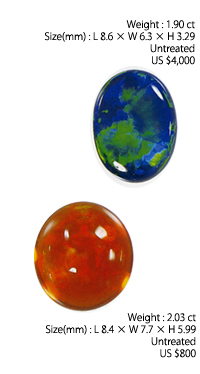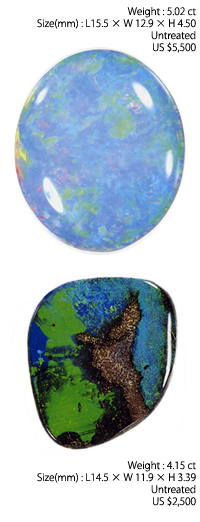SOURCES AND VARIETIES
Australia is currently the primary source of opal, proving an estimated 90 percent of total world production. The chief producing state differs with each variety of opal. |
Black Opal
Light opal and black opal are broadly classified by body color. Light opal refers to those with a body color that is colorless or white to medium-gray in tone, while black opal refers to those with a body color that ranges from dark gray to black. |
 |
Fire Opal
The commercial sources of fire opal are the Querétaro and Magdalena areas in Mexico, where mining started in 1870. Due to its high water content, fire opal has a low density. Quite a bit of the so-called “Mexican opal,” with its remarkable play-of-color, was imported by Japan in the 1960s, and some of these opals were subject to surface cracking due to dehydration. |
|
Light Opal
Coober Pedy and Mintabie in South Australia are the sources of most of the world’s light opal, with rough material being exported to Hong Kong and Germany for polishing. Thus, most of the light opals sold in Australia are polished in Hong Kong and Germany and imported back into Australia. Since shipping costs for gemstones are low, merchandise easily finds its way to the optimum polishing centers. |
 |
Boulder Opal
Boulder opal is opal that is polished leaving the ironstone matrix found in the rough material as part of the finished stone. Central Queensland in northeast Australia contains several hundred square kilometers of boulder opal fields. Value is determined by the intensity of the play-of-color and how the matrix is incorporated into the stone. The value of boulder opal is about one-third that of black opal of similar beauty. |
|
 |
JUDGING QUALITY
The criteria for judging the quality of gemstones always come down to beautiful brilliance and color. Depending on the gem, one or both of these elements may be the deciding factor. Superb brilliance is the key factor in diamonds, whereas color is paramount in emeralds or jade. Opal is a good example of a gem where combined brilliance and color determine the beauty grade. Strength of color and vivid clarity are absolute requirements for a fine opal. This brilliant and dazzling appearance may even be called the “brilliancy of color” in opal.
As shown in the quality scale to the right, an opal with dull color lacks beauty, resulting in a beauty grade of C or D. An opal showing a lot of red is considered desirable, assuming a clear brilliancy. This means that an S grade opal exhibiting red is extraordinary, but a D with red is still poor quality, and the red color becomes meaningless. Also, it is generally true that a fine blue S will be more attractive than a fine red A.
Opal’s low hardness of 5 to 6  , coupled with its high water content, make it susceptible to crazing (cracking) when exposed to heat. Careful handling is extremely important. It is also important to remember that doublets (assembled opals) and treated black opals may look attractive, but have little value. , coupled with its high water content, make it susceptible to crazing (cracking) when exposed to heat. Careful handling is extremely important. It is also important to remember that doublets (assembled opals) and treated black opals may look attractive, but have little value.
|
| |
|